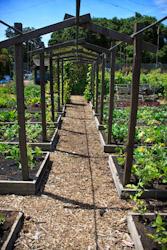Healthy Gardens Grow From Healthy Soil
Everything in your garden begins with the soil. According to the Master Gardener Handbook, “perfect soil” consists of 25% Air, 25% Water, 5% Organic Matter and 45% Mineral Matter. We classify soils depending upon the size of the soil particles. Soil Particles range from large or “Sandy” to medium or “Loamy” to very fine or “Clay” with Loam being considered the best for growing plants. Here in Alameda County, most areas have clay soil, but there are a few places with sandy or loam soils.
The Mineral Matter in your soil determines its:
- Air and Water Content
- Texture
- and “Tilth” – Defined as “the fitness as a medium for growing plants & other organisms.”

To determine what kind of soil you have, squeeze some damp soil in your hand. If it falls apart when you let go, it’s sandy, if it stays together, it’s loam and if you can extrude it from your hand in a strip, it is clay.
Soil Type |
Benefits |
Detriments |
|
Sandy |
Easy to work | Doesn’t hold a lot of water |
|
|
Weeds pull easily | Low nutrient content |
|
|
Large air pockets | |
|
Clay |
Holds water | No air pockets for oxygen |
| High nutrient content | Harder to pull weeds | |
| Can be hard to work soil |
Since most of us don’t have the mythical Loam soil, we need to amend our soils with:
- Compost – (see Improve Your Soil With Compost) Compost will improve Tilth of both clay and sandy soils, making clay easier to work and increasing air pockets for plants and allowing sandy soils to hold more water. It will also provide some nutrients to soil and serve as a host to living organisms like fungi, bacteria and earthworms. (75% of plants form associations called mycorrhizae with fungi which help them take up nutrients.)
- Fertilizer – (see Adding Fertilizer to the Soil) Fertilizer will provide nutrients that are necessary for plant growth, but which may be missing from soil. Sandy soil needs more fertilizer since nutrients wash out of soil more easily.
Further Reading:
Home Gardens and Lead
(PDF)

